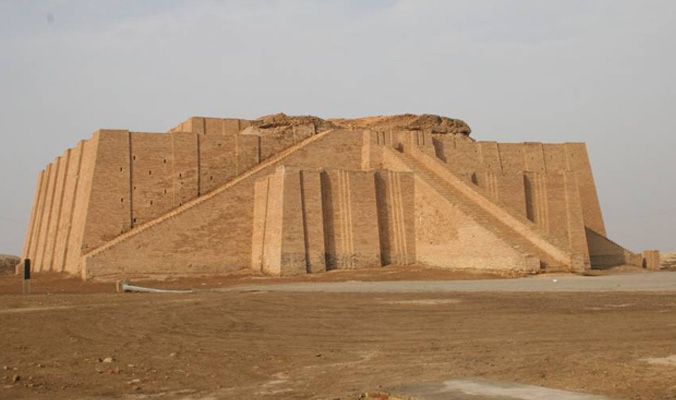Most of us tend to think of geometry as a relatively dry, if not altogether boring, subject remembered from our Middle school years, consisting of endless axioms, definitions, postulates and proofs, hearkening back, in fact, to the methodology of Euclids Elements, in form and structure a masterly exposition of logical thinking and mental training but not the most thrilling read one might undertake in their leisure time. While the modern, academic approach to the study of geometry sees it as the very embodiment of rationalism and left brain, intellectual processes, which indeed it is, it has neglected the right brain, intuitive, artistic dimension of the subject. Sacred geometry seeks to unite and synthesize these two dynamic and complementary aspects of geometry into an integrated whole. Robert Lawlor addresses this fundamentally dualistic nature of geometry in his essential work: Sacred Geometry – Philosophy and Practice (1982), in reference to a medieval representation of geometry as a woman seated at a table, with compasses in hand, surrounded by the implements of the art:
“Geometry as a contemplative practice is personified by an elegant and refined woman, for geometry functions as an intuitive, synthesizing, creative yet exact activity of mind associated with the feminine principle. But when these geometric laws come to be applied in the technology of daily life they are represented by the rational, masculine principle: contemplative geometry is transformed into practical geometry.”
Geometry as a Woman
Lawlor here expresses a crucial idea in the definition of Sacred Geometry—it has both a contemplative side and a practical side, and an intuitive and intellectual side, it is an activity both right brained and left brained.
Further differentiating Sacred Geometry from the ordinary geometry of our school days is its’ relation to number and symbol. This difference, I think, is succinctly expressed by Miranda Lundy in her superb little book entitled simply Sacred Geometry (2001)
“Sacred Geometry charts the unfolding of number in space. It differs from mundane geometry purely in the sense that the moves and concepts involved are regarded as having symbolic value, and thus, like good music, facilitate the evolution of the soul.”
Sacred Geometry, then, charts the unfolding of number in space and has symbolic value and thereby has conferred upon it a qualitative status absent from common geometry. And here I must add that magnifying the inherent power of Sacred Geometry is the fact that it also charts the unfolding of number in time. This is an idea of such compelling ramifications that I must return to it in detail in another article.
At the very earliest appearance of human civilization we observe the presence and importance of geometry. It is clearly evident that geometry was comprehended and utilized by the ancient Master Builders, who, laboring at the dawn of civilization some four and one half millennia ago, bestowed upon the world such masterworks as the megalithic structures of ancient Europe, the Pyramids and temples of Pharaonic Egypt and the stepped Ziggurats of Sumeria. That geometry continued to be employed throughout the centuries from those earliest times until times historically recent is also clearly evident. That it was made use of by cultures far-flung about the globe is evident as well, finding expression in China, Central and South America, in pre-Columbian North America amongst Native Americans, in Africa, SE Asia and Indonesia, Rome and of course in classical Greece and in Europe, from the Megalithic era some 4000 years ago, as stated, and again some 3000 years later, magnificently expressed during the Gothic era of cathedral building.

Geometry is especially associated with Classical Greece and such illustrious figures as Pythagoras, Plato and Euclid, who wrote the first actual textbook on the subject, the aforementioned Elements. Geometry has also been held in particular reverence and high esteem by the ancient order of Freemasons, which, of course, hearkens back to the great Cathedral Building era of the 12th through the 14th centuries, from whom modern Masons derive their pedigree.
From the foregoing is should be obvious that geometry was, and is, closely associated with Architecture, that great manuscript of the human race, which provided the first and primary vehicle for the human employment of geometry. That it is closely associated with Art, Music and Handicraft is obvious as well to the student of the history of these subjects. Ultimately, it must be appreciated that it was apparent to archaic peoples, as it is becoming increasingly apparent to contemporary students of the subject, that geometry is intrinsic to the very order of Nature itself, both biological and cosmic, and, now, thanks to scientific inquiry, the realization dawns that geometry lies at the basis of the molecular and atomic levels of creation.
The word Geometry itself means ‘Earth measure,’ which definition is generally attributed to the fact that the ancient Egyptians regularly utilized geometry to resurvey the fertile farmlands of the Nile river floodplain in late summer, after existing boundaries were buried by the deposition of thick layers of alluvium from the annual flooding of the river. However, I would suggest the possibility that the idea of ‘Earth measure’ applied not only to the local measure of tracts of agricultural land in Egypt, but also on a much larger scale, literally, to the measure of the Earth itself, in a geodetic sense. More on that compelling idea later.
Anecdote has it that over the entrance to Plato’s Academy was inscribed the phrase “Let none enter here who are ignorant of geometry.” Whether or not this is a historical fact, the idea should make sense to anyone who has attempted to ascend the heights of metaphysical experience and knowledge, that a form of mental training designed to develop the rational faculties and the reasoning ability to high levels of proficiency, would be a prerequisite for successful completion of the metaphysical journey and avoidance of the many traps, snares and pitfalls that await the inattentive pilgrim who presumes to tread the path of knowledge.
An old Masonic lecture from several centuries ago states:
“If we consider the symmetry and order which govern all the works of creation, we must admit that geometry pervades the universe…By geometry we may curiously trace nature through her various windings to her most concealed recesses; by it we discover how the planets move in their respective orbits and demonstrate their various revolutions; by it we account for the return of the seasons and the variety of the scenes which each season displays to the discerning eye……By it we discover the power, wisdom and goodness of the Grand Artificer of the Universe and view with delight the proportions which connect the vast machine…”
‘Demiurge’ by William Blake
We are here introduced to a another fundamental idea lying at the heart of Sacred Geometry,— that it provided the means by which God, as the Great Architect of the Universe, was able to frame the template of Creation. Freemasons, Hermeticists and Initiates into the Mysteries have for centuries held the conception of the Universe as the material expression of a hidden reality, an invisible blueprint, set down by the hand of the Grand Geometrician, and to which the study of Geometry provided the key and the means to render visible that which is concealed from the undiscerning and untrained eye, and that these fundamental geometric relations, manifested through form, pattern and number, form the very basis of harmony.
The idea, vision rather, of God as a Great Architect and Geometrician has found expression through numerous sources throughout the ages. The great Christian theologian St. Augustine, who held both Pythagoras and Plato in high regard, grasped the significance of geometric form, pattern and proportion, and their representation through numerical symbolism, when he stated:
“Numbers are the thoughts of God.”
And further when he said:
“The construction of the physical and moral world alike is based on eternal numbers.”
Galileo clearly understood this geometrical/numerical dimension of reality when he said:
“Mathematics is the alphabet with which God has written the universe.”
And so did Johannes Kepler when he said:
“Geometry existed before the creation. It is co-eternal with the mind of God…Geometry provided God with a model for the Creation…”
Here in the Keplerian view Geometry is clearly envisioned as existing upon an archetypal level, prior to the manifestation of material creation, and serving as the model utilized by the Great Architect. Through the study and practice of Sacred Geometry this invisible geometric matrix begins to reveal itself as the template upon which the material universe, expressed through space and time, has been framed by the hand of the Great Architect.
The famous early 20th century architect Le Corbusier obviously appreciated the fundamental idea of archetypal geometry and its’ expression through number when he wrote:
“Behind the wall, the gods play, they play with numbers, of which the universe is made up.”
As did French architect Paul Jacques Grillo, who wrote:
“The world around us is a world of numbers―numbers that spell life and harmony. They are organized by the geometry of figures, all related to one another according to a sublime order, into dynamic symmetry. Glimpses into this magnificent kingdom form the basis of all our knowledge and it seems that in this domain the ancient civilizations had gone further than modern science.”
Form Function and Design (1960)
The term ‘dynamic symmetry’ refers to a concept that we will explore in depth a little further on. For now let it be said that dynamic symmetry describes a way of dividing space such that there is a specific relationship between the parts of a spatial composition and the whole of that composition, a specific relationship that can be expressed by certain constants of proportionality, as for example, the square root of two, or the square root of three, the Phi ratio, and so forth. Stated simply, dynamic symmetry is the idea of dividing space such that the proportions of the whole are found in the parts. Probably the most well known example of this principle is found in the famous Phi ratio, which, in its simplest representation as a straight line, is divided asymmetrically such that the small segment is to the large segment as the large segment is to the whole line. I will have much more to say about this proportion later on.
The Golden Mean or Phi Ratio
It is extremely interesting that Grillo recognized, back in 1960, when the source of the above quote was published, the significant fact that ancient civilizations were highly knowledgeable of the domain of number and geometry to an extent completely unappreciated by conventional scholarship of his time. Implicit in this idea regarding the degree of advancement of ancient cultures, is the recognition that a study of Sacred Geometry requires an immersion into the history and meaning of the archaic cultures for whom it provided a vehicle to produce some of the most awe-inspiring demonstrations of symbolic and sacred architecture to have been conceived and executed by the mind and hand of mankind, while at the same time providing a path to a deepened spiritual awareness of the fundamental principles of creation.
It could be said of Sacred Geometry that it provides one of the most, if not the most important key to unlocking the great Mysteries of the Ages. According to the famous 17 century Alchemical tract Atalanta Fugiens the great Hermetic Secret lies concealed behind the ‘Wall of Mystery’ which can only be penetrated through an astute employment of geometry.
The great Hermetic Secret lies concealed behind the ‘Wall of Mystery’ which can only be penetrated through an astute employment of geometry.
In the lodges of old, as in schools of Plato and Euclid the tools of Geometry were simply an unmarked strait edge and a pair of compasses. That’s all. With those two tools it was possible to draw straight lines and circles, or arcs of circles. Out of the combination of straight lines and arcs the entire edifice of Euclidian geometry could be generated. In the archaic conception, God was seen as working only with lines and arcs, or circles, to create the entire manifested universe. In modern language we might think of vector forces and scalar forces. Through a simple act of geometric construction using these two tools two lines could be drawn that intersect at an angle of 90 degrees. The same act of geometry can yield an intersection forming an angle of 60 degrees. These two angles lie at the base of the two great systems of Masonic geometry, Ad Quadratum and Ad Triangulum, that is ‘of the square’ and ‘of the triangle’, respectively, and, through their marriage emerges an infinity of form.
In a small handbook frequently given to newly initiated Freemasons we find a valuable elucidation on the meaning of Geometry:
“Geometry is an ‘exact’ science. It leaves nothing to chance. Except for its axioms, it can prove everything it teaches. It is precise. It is definite. By it we buy and sell our land, navigate our ships upon the pathless ocean, foretell eclipses, and measure time. All science rests upon mathematics, and mathematics is first and last, geometry, whether we call its extension ‘trigonometry’ or ‘differential calculus’ or any other name. Geometry is the ultimate fact we have won out of a puzzling universe….There are no ultimate facts of which the human mind can take cognizance which are more certain, more fundamental, than the facts of geometry.”
Foreign Countries (1925) Carl H. Claudy
A study of Sacred Geometry begins with the hands-on experience, the commission of a geometric act of creation, utilizing only the straight-edge for drawing lines and the compasses for the drawing of arcs. Following from engagement of the hand and eye, the most basic of geometric axioms can be easily and intuitively grasped by the mind. Familiarity with the simpler exercises is soon followed by an ever increasing mastery of the more complex principles. A comprehensive program of study would require both deep contemplation of the forms, patterns and proportions of Geometry and their meanings, as well as the ability to apply the knowledge of Geometry in practical applications of problem solving and creative work.
As we trace the manifestations of Sacred Geometry throughout history and around the world, we see that it is infinitely adaptable and constantly evolving. As we continue to recover from the wreckage of ages past and civilizations lost new knowledge and new understanding of our extraordinary cultural heritage, we begin to appreciate that Geometry played a profound role in opening up the mysteries and secrets of Nature to humankind, inspiring our predecessors on this planet to achieve glorious heights of creativity by mimicking the fundamental processes and harmonies of Creation. As modern science becomes ever more proficient at penetrating the finest recesses of Natures’ Order, we will have the opportunity to develop new and original applications of this ancient Craft.
It is difficult to convey the power of Sacred Geometry through the written word. It is best experienced first-hand through the process of geometric construction. In my classes and workshops over the years I have endeavored to provide students with the experience of Sacred Geometry by guiding them to a place where they can perceive for themselves the patterns and forms as they emerge beneath straightedge and compasses. And, I have attempted to show them examples of the myriad ways in which Sacred Geometry both conceals and reveals itself throughout the kingdoms of Nature, Art, Architecture and Life, and finally, to suggest the possibility of a revitalization of Sacred Geometry, that it might once again become a force for manifesting greater harmony in the world.
[Editors Note: If you are interested in taking Sacred Geometry classes or workshops with Randall please send us an email. Telecourses coming early 2013 for students outside of the Atlanta area.]










